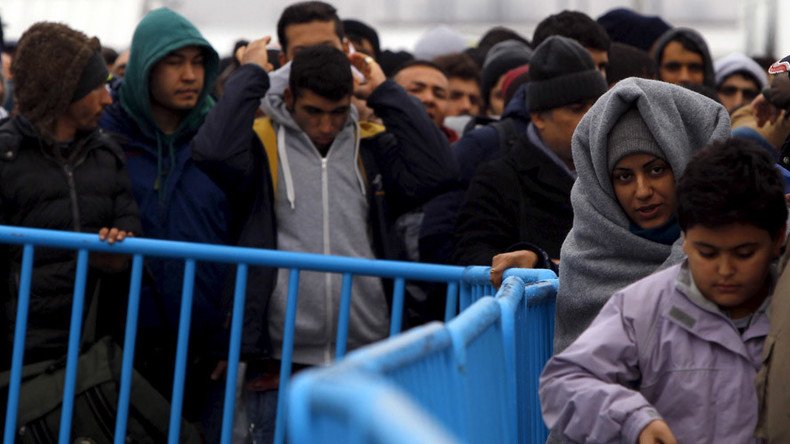A majority of people coming to Europe from the Middle East and Africa are economic migrants using asylum-seeker status as a cover, according to a top EU official. The EU may reinstate internal border controls if the crisis isn’t resolved in two months.
“More than half of the people now coming to Europe come from countries where you can assume they have no reason whatsoever to ask for refugee status… more than half, 60 percent,” said Frans Timmerman, vice-president of the European Commission, citing what he said were new, unpublished figures from the EU border agency Frontex.
Speaking on Tuesday with Dutch national broadcaster NOS, he added that these false refugees are mostly aspiring settlers from Morocco and Tunisia and are infiltrating Europe through porous Turkish borders in pursuit of better economic prospects.
Timmerman urged EU countries to accelerate the deportation procedure for those who pretend to be fleeing war or persecution. In this way, Europe would be able to provide support for those who need protection, he said.
Since last year Germany, Austria, France, Sweden, Denmark and Norway have reintroduced border controls for a maximum six-month term in a bid to curb the inflow of asylum seekers. On Monday, the European Commission said it could expand the temporary border checks for a period of two years, which is only possible if the existence of the Schengen zone is perceived to be in danger.
In January, Denmark imposed identity checks on its borders with Germany after Sweden introduced the same measure on its border with Denmark, causing transport delays of up to an hour.
Last year, Hungary built razor-wire fences on its borders with Serbia and Croatia in an unprecedented move to stem the migrant influx as more than 1,500 people a day entered the country. Last week, the country’s prime minister, Viktor Orban, called for fences to be built on the Macedonian and Bulgarian borders with Greece.
Hungary’s example has been followed by Austria, which constructed a 2.5-mile fence on its border with Slovenia, and by Slovenia itself – which built a fence along its border with Hungary.
The first deputy prime minister of Croatia, Tomislav Karamarko, announced last week that his country might follow the lead of Slovenia and other European countries.
"We will not allow Croatia to become a hotspot for refugees. How are we going to do that remains to be decided. I do not know the technical details of how that would be implemented, if it ever is. It all depends on what we agree with our allies," he said, as cited by Total Croatia News.
European Council President Donald Tusk warned that Europe has “no more than two months to get things under control.” If it failed to tackle the migration crisis before the EU summit in March, the bloc could “face grave consequences, such as the collapse of Schengen.”
The possible ending of the Schengen agreement may not alleviate the pressure to the extent its proponents are hoping for. Instead, it will surely inflict substantial damage on transportation and the European economy.
“There is no proof that bringing back border controls will help to ease the situation in terms of reducing the number of refugees,” Timmerman told NOS. He said it would be a “huge risk” which may result in “enormous economic consequences” and yet will not produce any positive outcome.
In the meantime, the Netherlands has decided to deploy police units on city streets and public locations such as railway stations and shopping malls. It is presumed that the officers will carry submachine guns, according to Dutch police reports.
The measure is seen as a response to the growing concerns that not only economic migrants but also Islamic terrorists could have entered Europe, posing as refugees.
“People may be shocked to see these officers, but the aim is to make the country safer for everyone,” a police spokesman said.
Last week reports emerged that a former Islamic State jihadist fighter might be living in Frankfurt along with the victims of the terror. “I was very scared that this terrorist is in a democratic state like Germany just living here,” said a refugee from Syria, who said he saw a man in Frankfurt resembling a member of the terrorist group he encountered in Syria. The police have launched an investigation into the case, but due to a complete lack of evidence are unable to charge the individual with any crime.
Europe has been experiencing the worst migrant crisis since the end of WWII. The number of asylum seekers passed 1 million by the end of November, according to Eurostat. However, the actual number of applicants will likely be much higher, as Finland was the only country to submit data up to November.
According to the Eurostat asylum quarterly report, released December 9, the number of applicants increased by more than 150 percent in the third quarter of 2015 in comparison with the same quarter of the previous year. The next report with updated figures is set to be published in March. Germany Interior Minister Thomas de Maiziere announced recently that his country alone has taken in nearly 1.1 million refugees.

